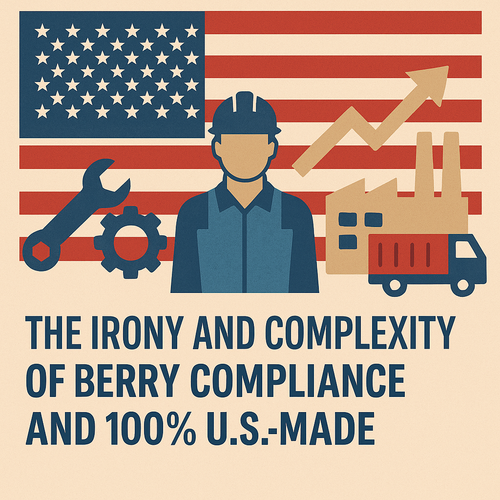The Irony and Complexity of “Berry Compliant” and 100% Made in the USA
Posted by Simon on May 8th 2025
The Irony and Complexity of “Berry Compliant” and 100% Made in the USA
By someone who has seen the inside of NATO projects and international defense supply chains
In today's world of globalized manufacturing, rising protectionism, and increasing demand for self-sufficiency, the concept of Berry Compliance and “100% Made in the USA” seems like a straightforward goal. It is a regulation rooted in national security and economic sovereignty — and when possible, it absolutely makes sense.
But as someone who has worked on multi-national defense projects, I’ve seen firsthand that reality is more complex than the label suggests.
The Reality: Even the Best Systems Depend on Others
Here’s where the irony kicks in.
I’ve seen defense projects where the product was 99% produced domestically, but one critical component — a microchip, polymer compound, or lubricant — had to come from an allied country or a single international source, simply because the U.S. didn’t produce it at scale anymore.
Examples:
- A fighter jet assembled entirely in the country may still rely on a rubber chemical sourced from overseas for its tires — molded in-house, but using the best-quality compound available elsewhere. And during a brief supply shortage, that material was temporarily sourced from another country to ensure the assembled product was completed on time.)
-
A radio may use a chip fabricated domestically, but with raw wafers sourced from abroad.
-
A parachute harness could be made from American nylon, but the dye or stitching thread may come from Canada or Korea — both NATO allies.
Why? Because rebuilding entire supply chains isn’t done in weeks or months. It takes years of R&D, investment, and scaling. In the meantime, the mission — and the contracts — must move forward.
Realism vs Idealism in Defense Manufacturing
The idea of “100% Made in the USA” is noble — and in some sectors, entirely achievable. But many great opportunities are lost or delayed when procurement officers or contractors bend the rules quietly or are forced to walk away from viable projects because one component doesn’t fit the box.
Sometimes, the better solution is Majority U.S. production, with strategic exceptions sourced transparently from trusted allies.
Strategic Supply Shouldn’t Be All or Nothing
There’s a difference between relying on adversarial economies vs leveraging allied supply networks. Berry compliance is about protection, not inflexibility. If we let perfect become the enemy of good, we may lose agility when it matters most.
As someone who values quality and national sovereignty, I strongly support Berry compliance — but I’ve also seen how flexibility, honesty, and long-term strategy must coexist with regulations if we want real resilience.
Conclusion
Yes, “100% Made in the USA” is the ideal. And yes, Berry compliance supports a more secure, independent defense industry. But in reality, many critical items — from fighter jets to fasteners — are international by necessity, not by choice.
The solution isn't to pretend otherwise. It’s to acknowledge the complexity, invest in what matters most, and stay strategic about how we build a sustainable, secure, and realistic supply chain for the missions ahead.

